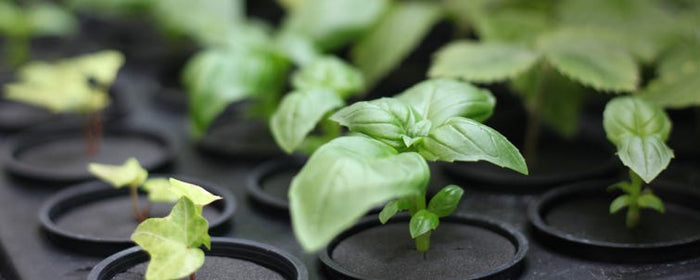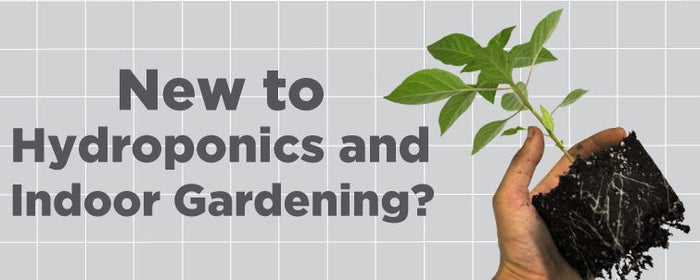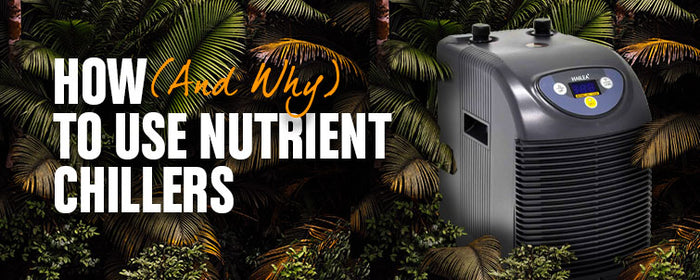
New To Hydroponics And Indoor Gardening?
Looking to get started growing with hydroponics?
Getting your indoor grow set up can look daunting. But don't worry, we've put together this how to set up an indoor grow guide to help get you growing quickly.Contents
- A QUICK INTRODUCTION TO HYDROPONICS AND INDOOR GARDENING
- GROW WHAT YOU WANT, WHEN YOU WANT!
- LOCATION, LOCATION, LOCATION!
- HOW TO SET UP A GROW ROOM
- FEEDING YOUR PLANTS
- READY, STEADY, GROW!
- GEARING UP TO GO AGAIN!
Honestly, getting to grips with the basics of hydroponics and indoor gardening takes minimal time and effort – in fact, finding your way to a good source of information is arguably the hardest part! And fortunately, you’ve arrived at one!
Now, where to begin? How about with…
1. A Really Quick Introduction To Hydroponics And Indoor Gardening
What Is Hydroponics?
It's where you grow plants without using soil. Instead, you use water.
Normally, a inert media (no nutritional content, like clay pebbles) are packed around plants to stop them toppling over. But plant roots themselves are exposed and grow straight into a oxygen and nutrient rich solution.
Instead of using standard pots, you'd either use a bubbler or growing system.
Without growing media:
- Roots are bigger and stronger
High oxygen content improves root health and growth. Plus there's no soil to get in the way of root growth
- Nutrient uptake is faster
Since roots are exposed to nutrients, oxygen and water 24/7, giving them unrestricted access. This, along with the extra root mass increases uptake.
- Plants grow bigger and yield better
Roots can support bigger, heavier plants!
- You have to pay close attention to your nutrient solution
There's no media to protect roots, so you have to keep your temperature spot on & oxygen level high to ward off diseases and algae. Soil also acts as a pH buffer, so without it you need to pay closer attention to your pH.
Is Growing Indoors The Same As Growing Outdoors?
Yes and no.
A lot of the same principles apply, but it's easier to control your plant & environment indoors.
You can tailor grow room to any species of plant - even ones you wouldn't normally be able to grow in the UK.
And you can grow all year round!
Better yet, with the ideal climate, plants produce a bigger yield.
Can I Grow Indoors With Soil?
Certainly! It is rather messy and results won't be as good.
BUT soil is very forgiving, and great for beginners.
There are lots of media and media mixes you can try. Lots of growers like mixing clay pebbles with their soil to improve air content.
Coco (made from coconut husk) is a nice step up - you've still got media to insulate roots. But it has no nutritional content so you get total control over your feeding regime.
Which Growing Media Should I Choose?
Depends on your goals and confidence.
Soil often suits beginners and organic growers
Coco is a great stepping-stone for soil growers who want to work up towards hydroponics. You will need to be confident enough to monitor and tweak your pH & nutrient strength though.
Hydroponics is very clean and efficient. But really, this method's all about increasing your yield. No other growing method can compete.
Should I Be Cautious Of Anything In Particular?
The main things to look out for are:
- extreme temperatures
- bugs
- disease - e.g. root rot and bud rot
With a suitable ventilation system, pest management strategy and plant health maintenance regime, there's nothing to worry about!
2. Grow What You Want, When You Want!
Almost anything - lettuce, tomatoes, peppers, strawberries - even bananas!
Most plants will really flourish, but each one inevitably has very specific needs.
To start with, you can't go wrong with a hardy chilli plant. We love them!
Can You Give Further Advice?
Do your research - work out what the plant will need, and if you're able to provide it. For some help and guidance, visit a shop, start a live chat or give us a call.
3. Location, Location, Location!
How Much Space Do I Need To Grow Indoors?
A spare room, empty garage or vacant loft will be ideal. Then again, you can use the corner of a room or even a closet if space is at a premium! Look for an available area of at least 75cm x 75cm.
Is There A Minimum Suitable Height?
Be aware that grow lights generate heat. You'll want to leave a safe gap between them and your plants.
For a main tent (veg & flowering), you could get away with 160cm tent. But we’d suggest no less than 180cm.
If you don't have much height to play with, pick a low profile light and growing system.
What Temperatures And Humidity Will My Plants Thrive In?
You need to keep a close eye on your grow room temperature, nutrient temperature and relative humidity.
It does depends on the plant, but aim for 24oC - 28oC. To stay in this range you may need to heat in winter and extract more air in summer.
Your relative humidity tells you how full of water vapour your air is. If your RH was 100%, it would be full to capacity. What you aim for depends on your temperature and stage of growth. As a rough guide, aim for 70 - 85% (propagation), 65 - 75% (veg) and 45 - 65% (flowering).
Too cold and you'll shock plants. Too warm, and root diseases can become a threat. The ideal nutrient temperature is 18oC-21oC. Nutrient heaters and chillers can help you stay inside this range.
What Else Do I Need To Take Into Account?
Make sure fresh, CO2 rich air can reach plants.
Normally, you can get away with some air vents. Air will passively enter to replace the air you're extracting. For best results, use an intake fan.
You must also size up your growing system before buying. Does it take up too much height? Will plants have room to grow?
4. Setting Up A Grow Room
What Are The Main Things I Need?
Once you’ve identified a location, you need your equipment.. You'll need:
- a ventilation system
- a lighting system
- a growing system.
We also recommend installing a grow tent rather than just attaching reflective sheeting to your walls.
Why Should I Use A Grow Tent?
It's a smaller space to manage, so gives you greater control. It's also easier to keep bugs away from plants.
Why Do I Need A Ventilation System?
Plants use CO2 from the air, and release O2 and water vapour. At the same time, lights are emitting heat.
You need to draw out hot, humid, CO2 depleted air and replace it with with cooler, dryer, CO2 rich air.
The extraction system (fan, carbon filter & ducting) of usually hangs towards the back of the tent. The intake vents should be on the opposite side of your tent, towards the ground.
How Do I Create A Lighting System?
If you're talking about an HID light, you'll need:
- Reflector: Beams light down to plant
- Lamp: Emits grow light
- Ballast: Controls power supply to lamp
- Timer: controls on/off times
- Contactor: to protect your timer from power inrushes
- Hangers: for suspending your lights.
Or you can use an LED light.
What's The Best Growing System?
It depends on what you need. Pick one that:
- Is the right size / shape
- Suits the number of plants you're growing
- Is easy to manage
- Suits your chosen growing method.
Are There Any Other Items Of Equipment I Should Know About?
Yes - there are lots of essentials you should always have on hand (scalpels, pipettes, measuring jug, sprayer, trays, nutrients, boosters, media, heaters, drying racks). It doesn't hurt to have a spare timer, bulb, contactor and nutrient pump handy over holiday periods in case yours fails and you can't get a replacement.
5. Feeding Your Plants
How Do I Feed Plants In A Hydroponics Set Up?
By creating nutrient solutions. You basically just fill a bucket or tank with water and let it stand for 24 hours (to de-chlorinate) and then mix in an appropriate amount of base nutrient, which contains key elements for growth. Adding stimulants and boosters will up the amount of certain elements, leading to all sorts of different benefits. You also need to appreciate how pH levels have an impact on the availability of nutrients, whilst conductivity (CF/EC) indicates nutrient strength and the suitability of feeds for plants.
All nutrient brands provide (or have available feeding charts, so you know how much nutrient to mix with your water.
Have I Got To Feed Soil-Based Plants Or Are There Nutrients In The Media?
Some soils feature enough nutrient content to get you through propagation (BioBizz Light Mix) and the early vegetative growth stages (BioBizz All-Mix), so you only need to give plants water at these times. Later ‘grow’ and ‘bloom’ feeds are still required – just like for hydroponics. The only major difference between hydroponics and soil feeds is that the latter doesn’t require pH and CF checks/adjustments.
What Do Plants Growing In Coco Need?
Coco closely mirrors hydroponics when it comes to feeds – you can even use the same additives! However, coco specific formulations will deliver the best results for base nutrients.
How Often Should I Feed My Plants?
In anything other than standalone pots, your plants will automatically be fed nutrient solution. We recommend completely changing nutrient solutions as opposed to regular top ups. If you can only do the latter more often than not, make sure it is all replaced at least once every 1 or 2 weeks, with ¼ strength feeds between changes.
For plants in standalone pots of soil or coco, conduct feeds with a watering can, bucket or large measuring jug. Afterwards, lift each plant to get a sense of how heavy they feel when “full”. Then every now and again check the weight to see if your plants have been drinking. The “lighter” they feel, the more likely they’ll need a feed sooner rather than later.
What Additives Shall I Give My Plants And When Is It The Best Time To Do So?
If you are growing plants in soil, stick to soil-specific additives (not that this is a limitation, there are loads to choose from!)
Hydroponics and coco growers have got even more to play with than their soil counterparts due to the extra degree of control on offer. A wide array of stimulants now exist, letting you enhance almost every aspect of a plant for the end gain of bigger yields!
Are There Any Guides To Follow For Mixing Nutrient Solutions?
Yes. You’ll find feed charts for all of the big nutrient ranges on the relevant product pages of the GroWell website. They are in the ‘Related Product Information’ section (underneath the main image), as print-friendly PDF files.
6. Ready, Steady, Grow!
Is It Easy To Get Some Plants Started Off?
There are two methods for beginning a new crop – either you take cuttings or start off seeds. In both cases, the main objective is the production of roots. To do this you will need a propagator, a scalpel, rooting gel, measuring cup, fluorescent lighting, a sprayer, propagating media (products exist for hydroponics, coco, soil and organics) and cutting/seedling feed.
Starting from seeds has its advantages if you’ve not got a mother plant or are completely new to gardening.
Taking cuttings gives you the ability to clone an existing plant and continue the genetics – something every grower should want to do with a top performer. After all, this often leads to a replication of the original success!
When you are competent at taking cuttings, you ought to try out different types of equipment and products in an attempt to reduce rooting times and quicken up the overall grow cycle. For example, the propagator you choose to use can make a big impact.
What Needs To Happen Once I Can See Signs Of Root Development?
Roots will emerge from your propagating media 10 to 20 days after the seeds/cuttings have been started off. The plants are now rooted and ready for the next stage – transplanting. Here you aim to provide the plants with a more stable base ready for when they take up their final position in a main system or pot.
How Do You Move Your Plants Into A Main System Without Upsetting Them?
First it’s important to understand when to act. For adopters of hydroponics, the sight of roots pushing out of the bottom of the transplanting cube tells you the moment has arrived. If you’re intending to move a plant growing in coco or soil from a small pot to a large pot and can’t see the roots, you must make a judgment call based on the development of the foliage.
What Is Necessary To Accelerate And Prolong Plant Growth?
When you move your plants into the main system they will be at the vegetative growth stage of the lifecycle. Keeping the focus on root and foliage development encourages them to become bigger and stronger, improving the efficiency of internal functions and supporting the addition of numerous new flowering sites. An 18-hour light
7. GEARING UP TO GO AGAIN!
Keeping a clean grow space is essential to success!
Maintaining a clean grow space is crucial for successful plant cultivation. A tidy environment prevents pest and disease issues, ensures optimal resource utilization, and promotes healthy plant growth. A clean space reflects dedication to precision, resulting in higher yields and better quality produce.
Restock your essentials!
Prior to embarking on a new growth cycle, replenishing essential nutrients is a fundamental step. Restocking ensures that plants have access to the vital elements they require for robust development, strong root systems, and optimal yields. By pre-emptively addressing nutrient deficiencies, growers lay the foundation for a successful and thriving cultivation journey, enhancing the overall health and vitality of their plants.




